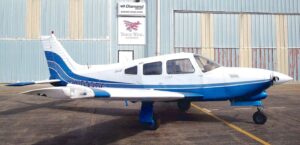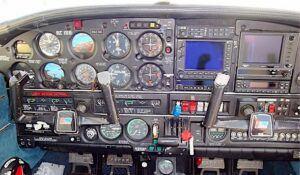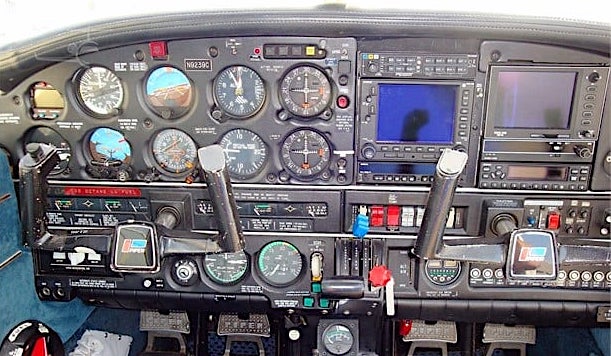1979-1984
In the spring of 1979, an angel entered my life. His name was John Smith and I owed him a not-too-small fortune. In one afternoon, he showed me how to change massive losses into equally large gains. The story of this failure and recovery is wonderful, rich, and complex, and I’ll share it in another post. In A Lifetime of Flying it’s the opening of the next chapter.
By 1982 time and money were again available concurrently. That elusive instrument rating was to be mine! Although it felt like starting all over again, the prior experience wasn’t wasted. With my mind focused, it took only about twenty hours with an instructor1 at Priester Aviation. This time I was ready. In fact, examiner Art Solberg told my instructor that she had done an exceptional job preparing me.
Since I expected to fly with some regularity, I joined Paragon Flying Club. They owned several single engine planes and kept them in prime condition. Whenever I wanted to fly, I was able to choose the plane with just the right price and performance.
At that time, my parents lived in Orlando, FL. It was always my dream to be able to hop down there for a quick visit. Jet set living. Yea.

One Thursday in November, I looked at the calendar and saw four days open before the next scheduled rehearsal of a community theater play I was in. And Paragon had a Turbo Arrow – perfect for a quick trip to Orlando. I would fly down on Friday, have dinner with my folks, spend Saturday with them, and fly home Sunday in plenty of time for the Monday evening rehearsal. And as an instrument pilot, I was confident that weather would not stop me.

But instrument flight does not render pilots safe from all weather hazards. Exceptionally low ceilings, icing, and thunderstorms can ground even airline pilots. When I called the FSS2 Sunday morning for my planned trip, the briefer laughed and said, “Not today.” Since I was new to the game, I asked him to go through the process even if it was futile. “Sure thing,” he said.

Planning for the trip from Orlando to Chicago required looking at weather forecasts covering half the country, including highs, lows, warm fronts, cold fronts and a whole bunch of other stuff. And the map for this trip showed them all:
- Centered over Atlanta – right in the middle of my planned route – was a deep low.
- Extending south to the Gulf of Mexico was a cold front producing thunderstorms with tops to more than fifty thousand feet and hail. Imagine the energy required to drive an ice cube up more than ten miles in the air. No place for me in my little plane.
- Past the stormy cold front, I could expect a warm front. Although the air was calm, there was a good chance of ICING in the clouds. Hmmm.
But what if I flew a hundred miles east of the cold front. I’d be safe and flying with a big tail wind to help make up the time lost going out of my way.
The warm front covering the rest of my route posed a different threat – possible ice. Closer examination, however, revealed that forecast visibility below the clouds was good. Ceilings throughout the area would be high enough that if there was anything I didn’t like I could safely get down through the clouds and land.
This trip was doable. There was a possibility – even a likelihood – that I’d have to spend the night somewhere in Ohio. But I’d be safe and would easily get home for the rehearsal.
As it turned out, the tailwinds were so strong that a controller seeing what type of plane I was in incredulously asked how I was going more than 210 knots (241 mph). And the ice in the north never materialized. I was home in time for dinner Sunday.
Two big insights I’ll never forget:
First, even though I was a newly minted instrument pilot, I took a big long trip. The knowledge and confidence I gained served me countless times in ensuing years.
Second, IF there are safe alternatives to possible nasty surprises, AND I’m able and willing to stop, I go for it.
Following the lessons learned on this trip, I’ve canceled only a handful of trips – fewer than if I had relied on airlines.
⨯ ⨯ ⨯
- I’m unable to credit my instructor. I love convertibles and have been lucky enough to have driven several. Early on, I concluded that I wouldn’t lock the doors – especially if I was parked in a bad neighborhood. My rationale was I’d rather the low-lifes simply stole my stuff rather than cut the top before they stole it anyway. I once foolishly tested the theory. Of course, I returned to find they had stolen my flight bag AND cut the top. Their crime was worthless to them. But I lost my logbook with about four years of history – including the name of the instructor that was so important in my journey.
- Before the internet, pilots turned to a network of Flight Service Stations (FSS) for up to the minute information on weather and airport conditions and to file flight plans. The briefers were enormously helpful and could be contacted either in person, by phone, or on the radio when airborne.
